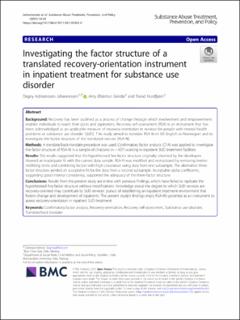| dc.contributor.author | Johannessen, Dagny Adriaenssen | |
| dc.contributor.author | Geirdal, Amy Østertun | |
| dc.contributor.author | Nordfjærn, Trond | |
| dc.date.accessioned | 2021-05-12T11:02:12Z | |
| dc.date.available | 2021-05-12T11:02:12Z | |
| dc.date.created | 2021-03-05T17:39:23Z | |
| dc.date.issued | 2021-03-19 | |
| dc.identifier.citation | Substance Abuse Treatment, Prevention, and Policy. 2021, 16:24, 1-12. | en_US |
| dc.identifier.issn | 1747-597X | |
| dc.identifier.uri | https://hdl.handle.net/11250/2755161 | |
| dc.description.abstract | Background: Recovery has been outlined as a process of change through which involvement and empowerment enables individuals to reach their goals and aspirations. Recovery self-assessment (RSA) is an instrument that has been acknowledged as an applicable measure of recovery-orientation in services for people with mental health problems or substance use disorder (SUD). This study aimed to translate RSA from US English to Norwegian and to investigate the factor structure of the translated version (RSA-N).
Methods: A translate/back-translate procedure was used. Confirmatory factor analysis (CFA) was applied to investigate the factor structure of RSA-N in a sample of clinicians (n = 407) working in inpatient SUD treatment facilities.
Results: The results suggested that the hypothesised five-factor structure originally obtained by the developers showed an inadequate fit with the current data sample. RSA-N was modified and restructured by removing twelve misfitting items and combining factors with high covariance using data from one subsample. The alternative three- factor structure yielded an acceptable fit for the data from a second subsample. Acceptable alpha coefficients, suggesting good internal consistency, supported the adequacy of the three-factor structure.
Conclusions: Results from the present study are in line with previous findings, which have failed to replicate the hypothesised five-factor structure without modifications. Knowledge about the degree to which SUD services are recovery-oriented may contribute to SUD services’ pursuit of establishing an inpatient treatment environment that fosters change and development of inpatients. The present study’s findings imply RSA-N’s potential as an instrument to assess recovery-orientation in inpatient SUD treatment. | en_US |
| dc.description.sponsorship | This study is part of a PhD degree which is funded by Blue Cross East in Norway. | en_US |
| dc.language.iso | eng | en_US |
| dc.publisher | BMC | en_US |
| dc.relation.ispartofseries | Substance Abuse Treatment, Prevention, and Policy;16:24 | |
| dc.relation.uri | https://substanceabusepolicy.biomedcentral.com/articles/10.1186/s13011-021-00363-0 | |
| dc.rights | Navngivelse 4.0 Internasjonal | * |
| dc.rights.uri | http://creativecommons.org/licenses/by/4.0/deed.no | * |
| dc.subject | Confirmatory factor analyses | en_US |
| dc.subject | Recovery-orientations | en_US |
| dc.subject | Recovery self-assessments | en_US |
| dc.subject | Substance use disorders | en_US |
| dc.subject | Translate/back-translations | en_US |
| dc.title | Investigating the factor structure of a translated recovery-orientation instrument in inpatient treatment for substance use disorder | en_US |
| dc.type | Peer reviewed | en_US |
| dc.type | Journal article | en_US |
| dc.description.version | publishedVersion | en_US |
| dc.rights.holder | © The Author(s) 2021 | en_US |
| dc.source.articlenumber | 24 | en_US |
| cristin.ispublished | true | |
| cristin.fulltext | original | |
| cristin.qualitycode | 1 | |
| dc.identifier.doi | https://doi.org/10.1186/s13011-021-00363-0 | |
| dc.identifier.cristin | 1895986 | |
| dc.source.journal | Substance Abuse Treatment, Prevention, and Policy | en_US |
| dc.source.volume | 16 | en_US |
| dc.source.pagenumber | 12 | en_US |

